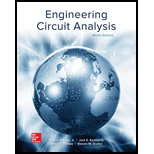
Concept explainers
A lossless LC circuit can be used to provide controlled oscillations to generate a controlled frequency for wireless communications. (a) Design an LC circuit with amplitude of 5 V and frequency of 400 kHz, where the largest possible inductor available is 400 nH. Now suppose that you have an undesired resistance of 0.2 mΩ in series with the LC oscillator. (b) Determine if, and how much, the frequency changes as a result of the resistance. (c) Determine the maximum time that the oscillator can run before the voltage amplitude decays to 4.8 V, and (d) determine the energy dissipation during this time period (it will be very useful to use software such as MATLAB for calculating the energy dissipation!).
Trending nowThis is a popular solution!

Chapter 9 Solutions
ENGINEERING CIRCUIT...(LL)>CUSTOM PKG.<
- Problem 1: Design a high-pass filter with a corner frequency of approximately fc = 200Hz. Your filter must ensure that at least 90% of the incident signal power is attenuated at f = 60 Hz. Verify the proper operation of your filter by using LTspice XVII to plot the magnitude and phase response of the voltage transfer function H(f). Show LTspice XVII Part if possible. DO NOT GIVE AI GENERATED RESPONSE OR I WILL DOWNVOTE.arrow_forwardHW_03.pdf EE 213-01 > Assignments HW_#3 uah.instructure.com b Success Confirmation of Question Submission | bartleby ✓ Download → Info × Close Page 1 > of 2 - ZOOM + 1) (5 pts) Use node voltage analysis at nodes A and B to determine values for VA, VB, I₁, 12 and 13. If a current has a negative value, then the reference direction chosen was incorrect and the current is positive in the opposite direction. Your answer can be the negative value – i.e. you find that 12 = -1mA. Note, the current through R5 is (VB - 28 Volts)/10K 10K VA 20K VB 10K R1 12 R2 R5 13 IS1 R3 10 mA 10K 28 V R4 VS1 5K -VREF B 2) (5pts) Use node voltage analysis to find values for the node voltages VA, VR and Vc. Use these node voltages to determine values for V1, V2, V3, V4, 11, 12, 13, and 14. Hints: V3 = VB and the value for Vc can be found with no analysis. Dependent current source has a value of gV3 amps VA gV3 Amps 14 12 20K + V2 - + 10K VB 13 V3 10K - 20K I₁ V₁ + Vc g=5x10-5 20 volts VREF 3) (5 pts) For the…arrow_forwardHW_02.pdf EE 213-01 > Assignments HW_#4 uah.instructure.com b Success Confirmation of Question Submission | bartleby ✓ Download → Info × Close 1) (5 pts)For the circuit shown, find the value of Ia, Ib, I¸ and Va: Ib 10 Ohms + Ic 20 Ohms 70 Volts Va 40 Ohms Page 1 > of 2 - ZOOM + Hint: use KCL to find Ic in terms of la and lb, use KVL around the right loop to find a relationship between la and lb, use KVL around the outer loop to solve for a current value (use ohms law for the voltage drops across the resistors) - 2) (5 pts) For problem 1, show that the power supplied (delivered) by the source equals the power absorbed by the resistors. 3) (5 pts) Determine the equivalent resistance looking into terminals a-b for the two circuits shown. Use series and parallel resistor combinations. Hint: work from the opposite end of terminals a-b towards terminals a-b a) 24 Ohms 10 Ohms 8 Ohms a REQ b) b = 75K 5 Ohms 50K 60 Ohms 4 OHMs 20 Ohms 30 Ohms □ a 20K 8.2K 40K 16K 10K □ b 7.2K REQarrow_forward
- A basketball coach needs to select 3 players from a group of 10. How many different teams can be formed?arrow_forwardA student organization has 12 members. A committee of 5members needs to be selected. How many ways can the committee be formed?arrow_forwardA fair coin is flipped 10 times. What is the probability that the coin lands on heads exactly 6 times?arrow_forward
 Delmar's Standard Textbook Of ElectricityElectrical EngineeringISBN:9781337900348Author:Stephen L. HermanPublisher:Cengage Learning
Delmar's Standard Textbook Of ElectricityElectrical EngineeringISBN:9781337900348Author:Stephen L. HermanPublisher:Cengage Learning
